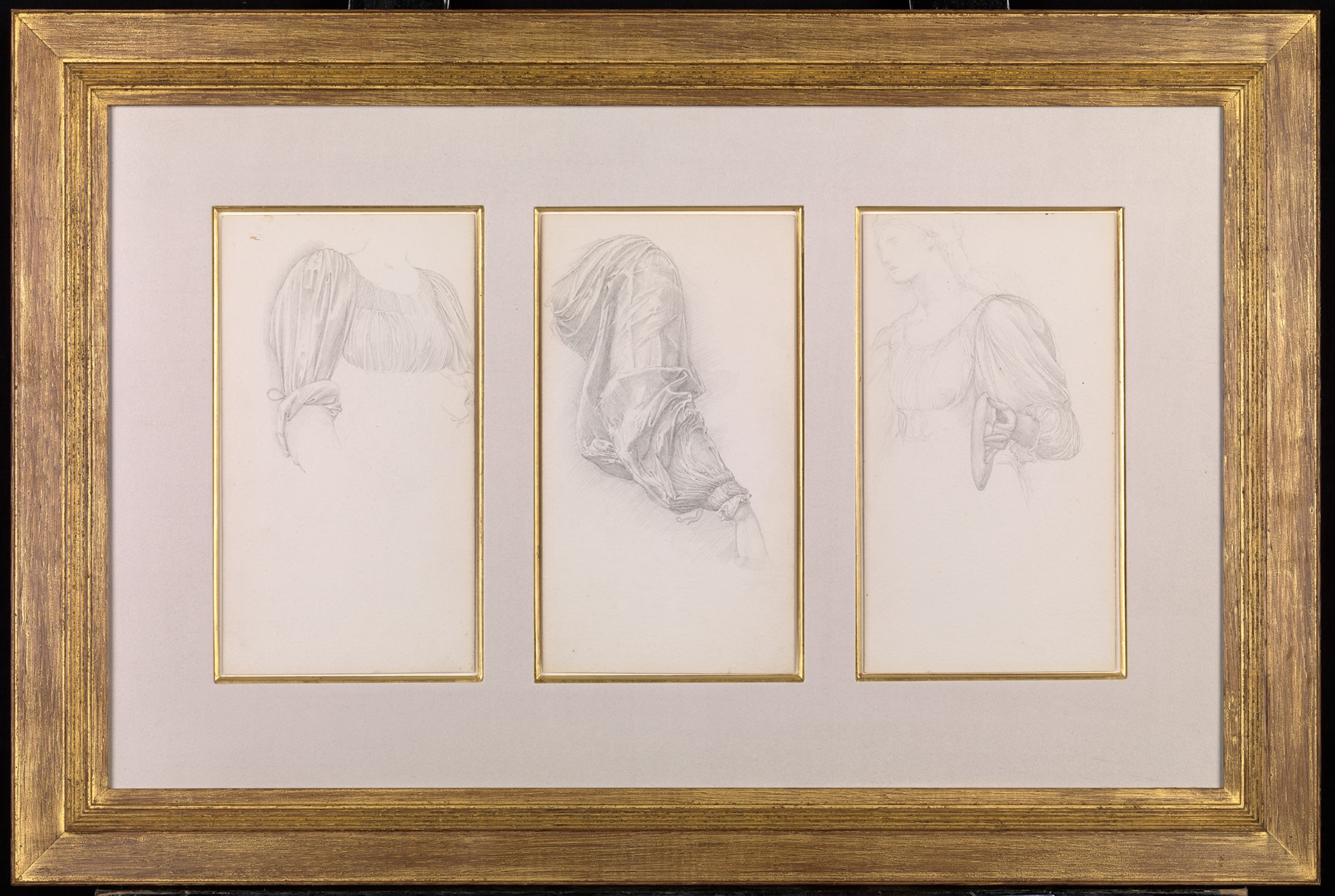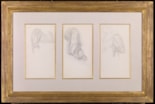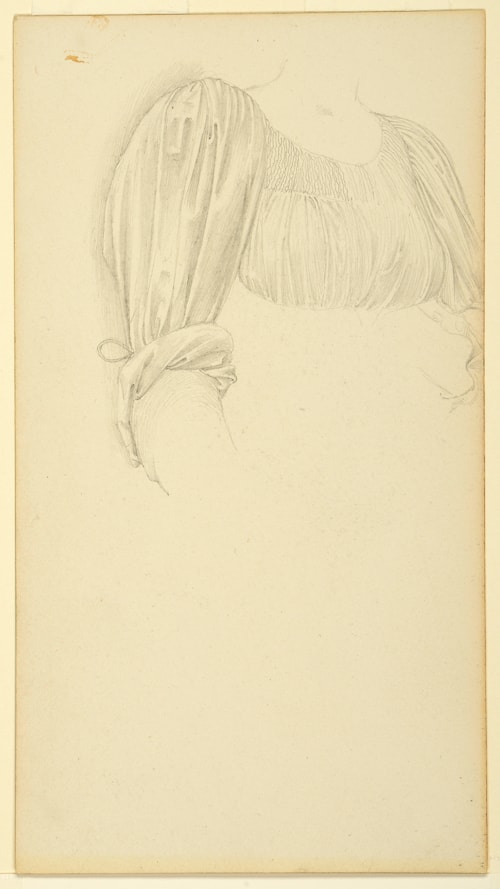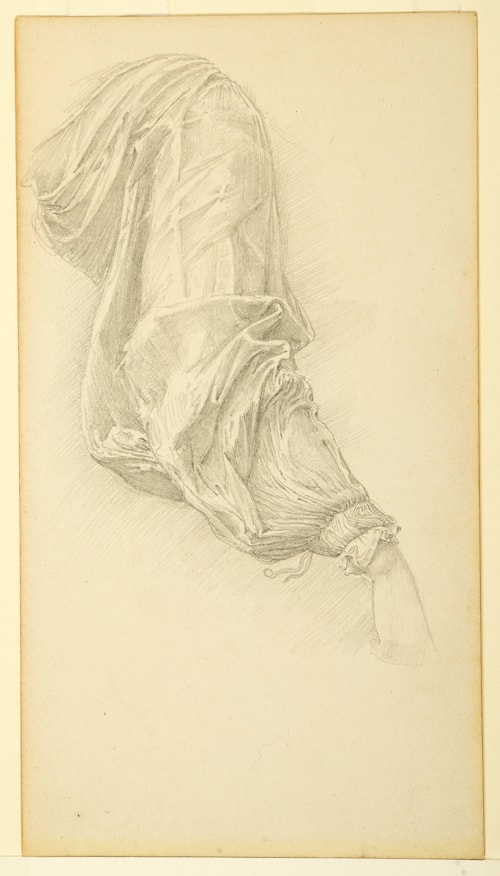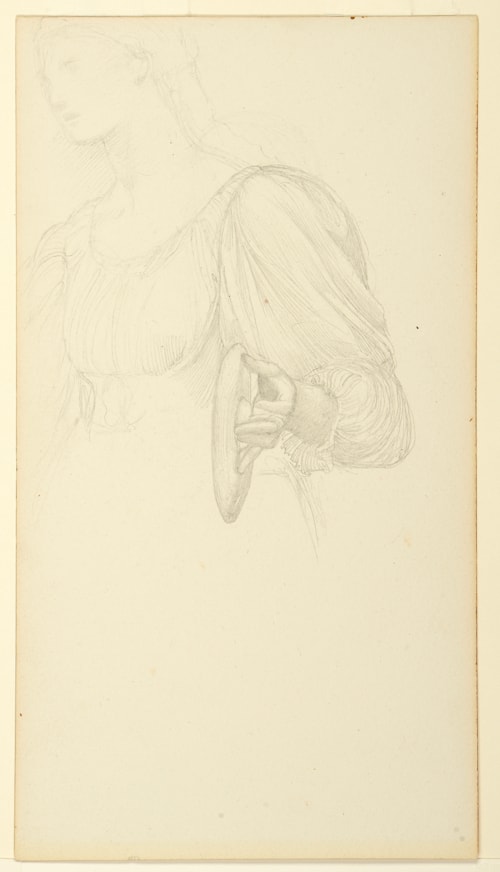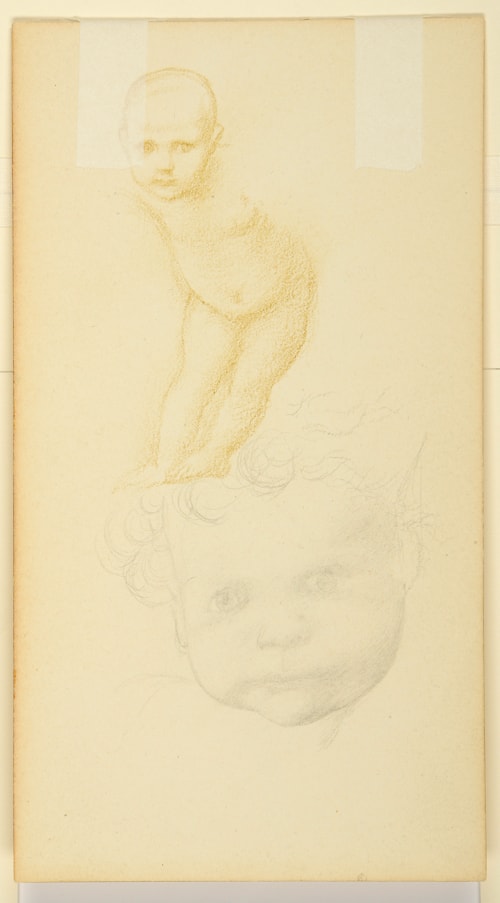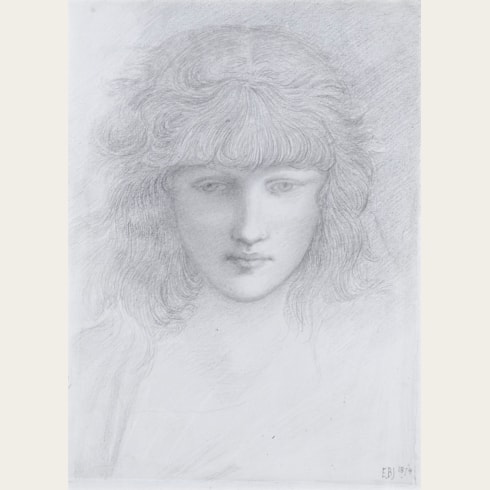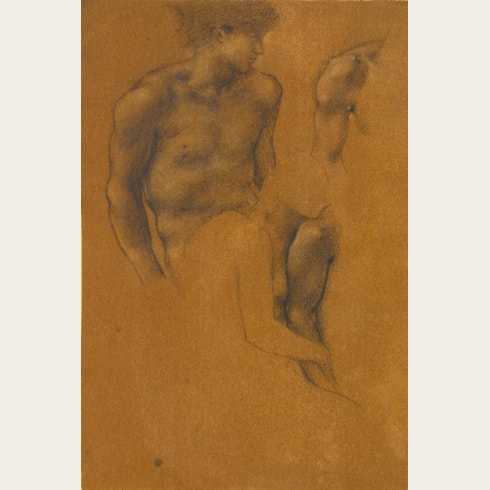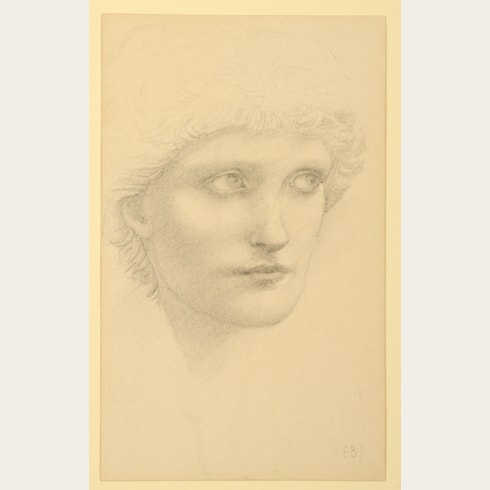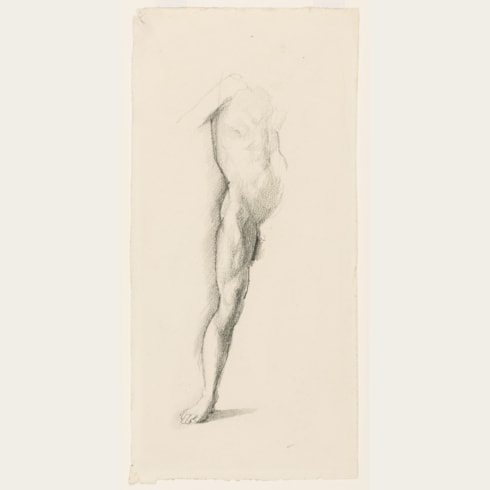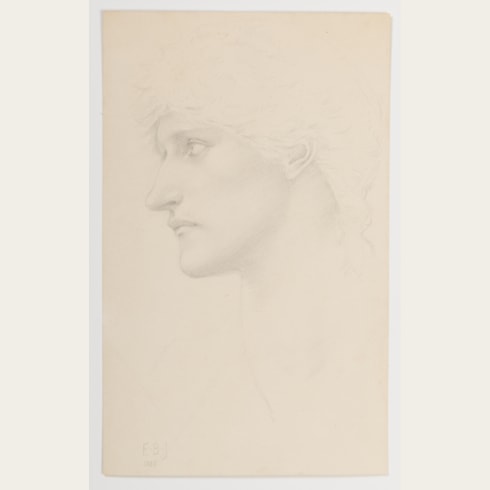Edward Coley BURNE-JONES
(Birmingham 1833 - London 1898)
Three Studies for The Golden Stairs
Pencil on paper; a page from a sketchbook.
A sketch of the head of a child faintly drawn in pencil on the verso.
255 x 140 mm. (10 x 5 1/2 in.)
b. Study of the Drapery of the Left Arm of a Woman
Pencil on paper; a page from a sketchbook.
255 x 140 mm. (10 x 5 1/2 in.)
c. Study of A Woman Holding a Cymbal
Pencil on paper; a page from a sketchbook.
A nude study of a baby and the head of a young child in brown chalk and pencil on the verso.
255 x 140 mm. (10 x 5 1/2 in.)
An anonymous review of the 1880 Grosvenor Gallery exhibition in the Times praised The Golden Stairs for its ‘beauty and grace, harmony of line, and tender colour, with a suggestion throughout of low-breathed music in the minor key.’ As the same review described the painting; ‘it represents a troop of fair minstrels, clad all in white, coming down a flight of stairs of paly gold, supported by a beautifully-curved arch, from a loggia, on the top of whose cornice doves are perched, while a small space of blue sky is visible through a corner of the square formed by the projecting rafters. The fashion of the dresses is hardly classical, or rather is classical of the renaissance, such as is often employed in the school of Mantegna. The draperies are of white linen, reaching to wrist and ankle, goffered in small plaits, fitting close to the form and confined by girdles. The girls are crowned with delicate garlands, and carry their instruments, ready to resume their playing when they have descended the stairs. The feet seem to fall in rhythmic harmony, and the faces are full of breathing music. Many, if not most, of them, are among the most beautiful that the master has painted, sad rather than joyous, but with a sadness that is tender and pleasing, not woeful and worn out, as this painter’s sadness is apt to be. The peculiar harmony of colouring obtained by the subtly-managed variations of white in the dresses, in combination with the pale gold of the steps and the delicate flesh tones of the faces and feet, is equally lovely and original…we have nothing but praise and admiration for the picture.’
Inspired by his trip to Italy in 1871, Burne-Jones began making drawings for the composition in 1872, but did not start work on the large canvas itself until four years later. Each of the figures in The Golden Stairs was studied from professional posed models, notably the Italian Antonia Caiva, who also worked for Lord Leighton and Edward Poynter. The heads of the women, however, were portraits of several young ladies in Burne-Jones’s circle, including his daughter Margaret and William Morris’s daughter May, as well as Frances Graham, the daughter of his patron William Graham.
The first of these drawings is a study for the drapery and upper torso of a woman, but does not appear exactly in the final painting. The second drawing is a preparatory study for the left arm and drapery of the woman bending down just above the centre of the right side of the composition, while the third drawing is a study for the woman at the very bottom of the steps, holding the cymbals. Another preparatory drawing for this last figure, containing three pencil studies of the left hand holding the cymbal, is in the Fitzwilliam Museum in Cambridge.
The Golden Stairs has been described as ‘the outstanding expression of a tendency, always implicit in Burne-Jones, to base a design purely on formal values of line, colour and surface pattern.’ The painting lacks any indication of a specific subject, and its title was chosen only after two others, The King’s Wedding and Music on the Stairs, were considered and rejected. As the contemporary critic F. G. Stephens noted of the painting, ‘The damsels…carry various instruments of music, such as cymbals, silver trumpets and pipes, tambourines, violas, and dulcimers. They troop past like spirits in an enchanted dream, each moving gracefully, freely, and in unison with her neighbours; some converse with a sweet seriousness which has an irresistible charm, some gaze eagerly forwards, others look backwards, some are lost in thought, but all are earnest, and every one is beautiful in face and form. Barefooted they tread the golden stairs with graceful and easy movement; each is unconscious of herself. What is the place they have left, why they pass before us thus, whither they go, who they are, there is nothing to tell.’ And, as John Christian has noted, ‘The Golden Stairs is the supreme example of a picture in which [Burne-Jones] deliberately evokes a sense of mystery and ambiguity, qualities which were to be central to European Symbolism a decade or more later.’
These three drawings were part of a previously unpublished Roberson & Co. sketchbook, numbered and dated XIV/1880, which contained several pencil studies for The Golden Stairs. The bound sketchbook belonged to the artist’s close friends Sir George and Lady Lewis, and remained in the Lewis family collection until it was broken up and the contents dispersed at auction in 2016. Other preparatory drawings by Burne-Jones for The Golden Stairs are today in the collections of the Fitzwilliam Museum in Cambridge, the National Gallery of Victoria in Melbourne, the Ashmolean Museum in Oxford, and elsewhere.
The leading member of the second generation of Pre-Raphaelite painters, Edward Burne-Jones studied at Exeter College, Oxford, where he met William Morris. The two were to remain lifelong friends and colleagues, with Burne-Jones executing designs for stained glass windows, ceramic tiles and tapestries for Morris and Company for more than thirty-five years. Another close friend was Dante Gabriel Rossetti, who gave Burne-Jones some of the little artistic training he received, otherwise being largely self-taught. From early in his career Burne-Jones enjoyed a measure of success, particularly as a designer of stained glass panels. In 1859 he made the first of four trips to Italy, a country whose art he found of considerable inspiration throughout his life. In 1877 he showed a total of eight paintings at the inaugural exhibition at the Grosvenor Gallery, established as a more radical alternative to the Royal Academy. The success of these pictures, and his continued participation in the yearly Grosvenor exhibitions, established Burne-Jones's reputation as a leader of the Aesthetic movement. His fame also spread to Europe, and in particular Paris, where his painting of King Cophetua and the Beggar Maid was greatly admired at the Exposition Universelle of 1889.
A passionate and prolific draughtsman, Burne-Jones produced countless preparatory studies and cartoons for his paintings, as well as drawings intended as independent works of art in their own right, in black and red chalk, pencil, pen and watercolour. His drawings were, indeed, of arguably greater significance to him than his finished paintings; as John Christian has noted, Burne-Jones ‘was always a draughtsman first and a painter second.’ Similarly, the artist’s friend Graham Robertson wrote that ‘He was pre-eminently a draughtsman, and one of the greatest in the whole history of Art…as a master of line he was always unequalled; to draw was his natural mode of expression – line flowed from him almost without volition.’ Although he occasionally gave drawings away as presents, and also sometimes exhibited them in public, Burne-Jones seems to have kept most of his drawings in his studio until his death, after which they were dispersed.
Provenance
Thence by descent to a private collection.

